13 Tracks that Inspired the Berklee Indian Ensemble's Grammy-Nominated Debut
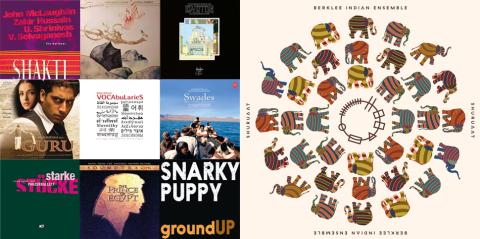
“The most amazing thing about BIE is that it’s like a large energy ball that absorbs all music that comes its way,” says Dhruv Goel B.M. ’15, vocalist and composer for the Berklee Indian Ensemble (BIE). That stylistic fluidity is on full display in the ensemble’s Grammy-nominated debut album, Shuruaat, where songs seamlessly incorporate influences and instruments that span the globe and draw from all corners of the musical world—from California to Bangladesh, from prog-rock guitars to Carnatic vocal techniques. It’s a porousness that reflects the inclusive spirit of the ensemble, which draws its expansive sound from a truly global collective of players, all united by their deep friendship and an interest in Indian musical forms, but each bringing their own personality and style to the mix.
As the group transitioned from a student ensemble in the early 2010s to the 12-member professional touring outfit it is today (students still have access to the ensemble’s academic successor, the South Asian Ensemble), this distinctive blend of influences has helped define the Berklee Indian Ensemble sound, even as the band continues exploring new sonic terrain. So on the heels of its Grammy nomination, what better way to dig deeper into the ensemble’s aesthetic than to hear what its members were listening to as they made Shuruaat?
Below, meet each member, learn about their path to the Berklee Indian Ensemble, and listen to the tracks that influenced their contributions to Shuruaat at the end of the article.
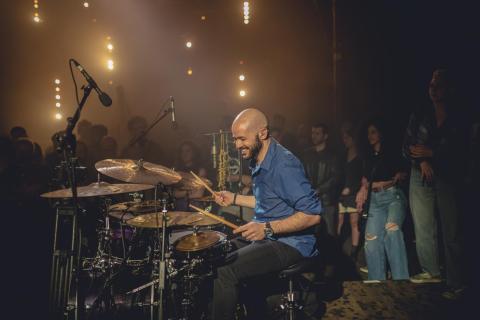
Yogev Gabay
Yogev Gabay B.M. ’16 (Israel)—Drums
Could you describe your musical background?
I started playing drums at the age of 8, and stopped two years in, after my teacher died. Picked it up again in high school, and started playing in local cover bands as well as in the city's youth brass orchestra, which is where I learned how to read music. Spent my army service in the army band and joined the Rimon School of Music (a Berklee global partner school) later on. Three years after that I came to Berklee and the rest is history. Or on Spotify.
How did you first come to the Berklee Indian Ensemble, and what kept you involved with the group?
I’ve been deeply interested in Indian rhythms forever, but sadly couldn’t find anything about it in Israel. When I came to Berklee, I got involved in a bunch of Berklee video sessions and was invited to play with a visiting Indian percussionist. Met Annette [Philip] there, sent my audition videos, got accepted, never left.
Besides the music being very challenging, new, and exciting, I really really got attached to the people involved, who are some of my best friends today. Also, the attention to detail that goes into literally everything this group does is something that resonates with me in the highest levels.
What's your favorite song on Shuruaat?
Oh boy. Who do you love more, mom or dad?
My top two, I’d say, are “Sundari Pennae” and “Unnai Kaanadhu Naan.” "Unnai" feels like the most stripped down “traditional” sounding Indian song, and I selfishly love my role there. I play these small Indian bells throughout the whole song; it’s great. And “Sundari,” it’s “Sundari.” I love the group effort that went into it and the prog element we’ve added, and I feel like that’s the direction we’re going more and more, which is great.
What's one piece of music that has inspired your approach to playing in this ensemble?
Listening to Snarky Puppy, specifically the Ground Up album, really taught me a lot about how to navigate and approach being a drummer in a large ensemble in addition to how to play when there is a lot of percussion involved. You can find a good example for this on the track “Binky,” especially the ending.
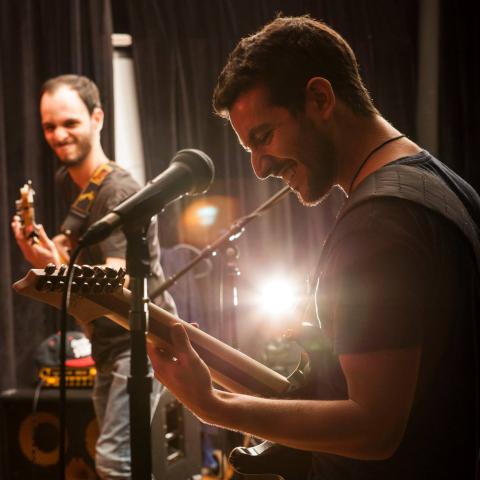
Yoel Genin
Image courtesy of the artist
Yoel Genin (a.k.a. Shwesmo) B.M. ’16 (Israel)—Guitar, Buzuki
Could you describe your musical background?
I started learning piano and music when I was 6. I’ve been composing music since I can remember myself. Discovered the guitar at 12 and never left it. Got into prog-metal music very early on as a teenager, and as my passion for music grew rapidly I felt that it was going to be what I do for life. I studied at Rimon School of Music for two years, and was lucky enough to be able to attend Berklee for another two years and complete my degree in jazz composition, where I also went back to more Middle Eastern roots of music, as well as progressed deeper into the jazz fusion world. Nowadays I’ve shifted gears a bit, combining my influences into the context of electronic bass music. Also grateful to come full circle and be faculty at Berklee.
How did you first come to the Berklee Indian Ensemble, and what kept you involved with the group?
Yogev [Gabay], who was the drummer for the ensemble at the time, told me I had to join him there because it’s amazing. I did. And he was right.
It opened up a door for me to explore a new style of music I wasn’t familiar with and at the same time have enough room to contribute my own musical ideas, and be myself stylistically (hence, buzuki, a greek instrument in Indian music). Above all, the Indian ensemble always felt like a big family that cared and enjoyed each other no matter what.
What's your favorite song on Shuruaat?
It’s a hard choice, but probably has to be “Dua.” I actually didn’t take part in recording it at all; it was completely new to me. It's such a great song—well written, produced, arranged, and performed.
What's one piece of music that has inspired your approach to playing in this ensemble?
It’s not a piece that got onto the album, but there’s an arrangement that we did in the ensemble early on when I got in, for the song “Rasaathi.” My role was to constantly play just a one note pattern, throughout the whole song. I learned so much from playing that song about arranging, patience, enjoying simplicity, and putting what the music needs first, rather than what I want to play. It’s a story I tell all my students in the [South Asian] Ensemble nowadays. Since this song is not on Spotify in our arrangement, I chose a different one—"Pink Panther" by Panzerballet—which is some of the inspiration for the more prog/fusion stylistic approach in songs in arrangements like “Sundari.”
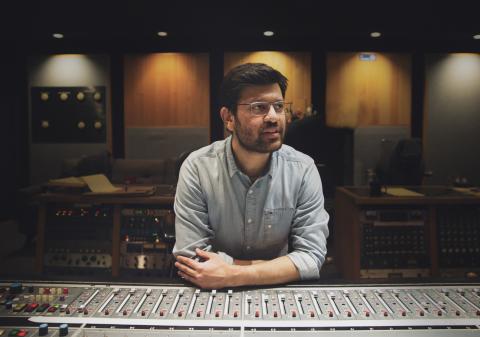
Dhruv Goel
Image courtesy of the artist
Dhruv Goel B.M. ’15 (India)—Voice
Could you describe your musical background?
I started singing and learning music when I was 4 or 5. One of my favorite childhood memories is of large family gatherings filled with singing, poetry, and joy. I think that is where I developed my love for music. I studied Indian classical vocal music under Pandit Nirmalya Dey through school and college (I studied economics as my first undergraduate degree in India). When I was around 18, I started performing and writing electronic/rock/jazz with a band and simultaneously started scoring short films. My love for scoring brought me to Berklee, where I studied electronic production and sound design. I have since moved to L.A., where I work as a film composer and music producer.
How did you first come to the Berklee Indian Ensemble, and what kept you involved with the group?
I had first seen Annette perform with her New Delhi group, Artistes Unlimited, back when I was in school. She was a hero of mine and actually guided me when I was preparing for my Berklee audition. After I came to Berklee, I met her the first chance I got, and the rest is history.
BIE is more than a family to me. I found some of my closest friends there who were with me during some of my hardest times. I am and will forever be grateful for them.
What's your favorite song on Shuruaat?
Wow, that is a hard question. I absolutely love all the songs on this album! But if I had to choose one, I would probably say “Jaago Piya.” From the day I first heard Armeen [Musa] sing the demo to when I hear it now, I get chills every time.
What's one piece of music that has inspired your approach to playing in this ensemble?
I think the most amazing thing about BIE is that it's like a large energy ball that absorbs all music that comes its way. A lot of genres and styles gently inform our sound. But what I love most about BIE is that it doesn't really fit any one box. My own musical influences are also quite eclectic, and range from Aaron Park’s album Invisible Cinema to film scores by composers such as Jóhann Jóhannsson and John Powell. But one of my biggest influences has been A. R. Rahman’s score and songs from the movie Swades, which paints a unique sonic landscape filled with big ensemble moments and electronic/produced elements—especially the song “Yeh Tara Woh Tara.”

Aleif Hamdan
Image courtesy of the artist
Aleif Hamdan B.M. ’15 (Indonesia)—Guitar
Could you describe your musical background?
I grew up in a household that played a lot of music, particularly the Beatles, João Gilberto, and James Taylor; that environment really shaped a lot of my sense of aesthetics. I picked up classical guitar when I was 8 but didn’t see myself finding any real passion until I picked up an electric at 12. I became heavily into playing the kind of music I grew up with, particularly blues and classic rock, and that really started the spark for many other styles to follow such as jazz and global music.
How did you first come to the Berklee Indian Ensemble, and what kept you involved with the group?
Eventually, as I got older, I discovered Hindustani classical music, which moved me immensely. Coming to Berklee in my first semester, I had seen a performance by BIE, and found myself being moved in the same way. It was something about the creative sensibilities the music had, a certain kind of sensitivity to melody and color which stood apart from the other styles I was exposed to at the time, so I couldn’t help but feel inspired to audition the following semester. Many years later I’ve continued to play an active role in the ensemble, not only for the music itself, but for the many communities and relationships the ensemble itself has managed to spawn. So many of my closest friendships and work relationships have risen out of the ensemble being a sort of melting pot for things to form. An environment as warm as this can be rare to come across in a large institute like Berklee. There are certain moments in BIE where you forget that it’s an academic/professional project; instead it starts to feel like a group of close friends getting together to have some fun and make something together, which ultimately makes the end result all the more inspired and sincere.
What's your favorite song on Shuruaat?
My favorite song on Shuruaat is “Pinha” by Dhruv Goel. To me it strikes a fine balance of space and intensity that makes it an addictive piece of music to listen to and play as well. Such songs can be medicinal with the right amount of different elements, albeit subjective to the individual; “Pinha” is the one that hits it for me.
What's one piece of music that has inspired your approach to playing in this ensemble?
Many pieces of music from many different artists; however, one that immediately comes to mind is the live version of “Dazed and Confused” by Led Zeppelin—it’s a very long live performance that absolutely showcases what the electric guitar is capable of doing from a textural/sonic perspective. It definitely greatly influenced the way I approach how to use my instrument to its full potential in a live band setting—it always reminds me to think and really feel out what it is that a certain song needs and if I’m really considering the full range of sounds my instrument can produce.

Rohith Jayaraman
Image courtesy of the artist
Rohith Jayaraman B.M. ’15 (U.S.)—Voice, Percussion
Could you describe your musical background?
I grew up in a singer’s house. My mom is a vocalist and educator, so from six in the morning to six in the evening, she would be in and out of classes, and then be off to rehearsal after dinner, coming home at midnight or later. Whenever I woke up, left for school, got back home, there was always music. In some ways, it feels like I didn’t have much choice in the matter. I was set up for a musical life from the start. My parents never really put any pressure on me to stick with any one instrument, style, or even with music at all. They really allowed me to have an organic relationship with music, which is why I find myself still practicing music today, I think. After over 10 years of learning Carnatic music (a traditional Indian style), among other things, I chanced upon Berklee when a family friend of mine, also an alum, told me to check it out. I did the Vocal Summit and Stage Performance summer programs and within a day of being on campus, I’d emailed my college application counselor that this was where I was going to go.
How did you first come to the Berklee Indian Ensemble, and what kept you involved with the group?
I remember sitting in the Berklee Performance Center for the convocation concert and seeing a bunch of musicians walk on stage, led by an unmistakably Indian woman in a sari: Annette. It was a bit surreal for me, which is a bit funny considering I come from the Bay Area, which is known for its large South Asian community. The band, which I later found out was called the Berklee Indian Ensemble, was full of people from around the world, but they played South Asian music and I was hooked. I remember asking to be placed in the ensemble during my ratings audition, but I was told that it may not be the best fit, given my existing background in Indian music. But, less than a month later, I was on my way out of the 1140 [Boylston Street building] after a private lesson and I heard Indian music coming from [room] 3F. I just sat down outside the classroom and started tearing up. I’d been at Berklee for a few weeks and hadn’t been playing Indian music at all. When the door opened, [former President] Roger [Brown] walked out with a few donors and trustees, followed by Annette. Not sure what they must have thought of a little first-semester student crying outside the classroom! In any case, Sashank, one of my friends and a sarod player, suggested I use this opportunity to speak to Annette about trying to join the ensemble. She very casually told me to drop by the vocal rehearsal if I have the time free on my schedule. A week later, I was part of the Berklee Indian Ensemble. That was 10 years ago. I’ve met some of my closest friends and collaborators—even my partner—all through this group. The music being incredible is almost just a bonus. Being in the ensemble is one of the most formative experiences of my personal and professional life.
What's your favorite song on Shuruaat?
I’m sure everyone will say this, but this is tough. At this point, I might have to stick with “Sundari Pennae.” This was the ensemble’s most collaborative arrangement, with every single person who played on the song contributing meaningful and incredibly interesting ideas, most often while we all sat in a room together to figure out the song. I can’t think of another song where it feels impossible to pinpoint one or more specific arrangers. It really belongs to the whole band. And, of course, the album version features the iconic Shreya Ghoshal.
What's one piece of music that has inspired your approach to playing in this ensemble?
I think there are two major influences here: A. R. Rahman and Shakti. In the ensemble, a majority of our repertoire falls into a contemporary Indian type of space. Despite his work being primarily film music, A. R. Rahman’s music sort of led the charge for what contemporary and popular Indian music sounds like today. If I have to pick a specific song that covers everything, it would be “Tu Hi Re” from the film Bombay. And then there’s Shakti, in my eyes (and ears) the best band of all time. They essentially created Indo-jazz fusion/crossover music and their technical skill, sense of time, joy, willingness to learn from one another, compositional prowess, and trust in the music and the players are just some of the things that make this band great. It’s incredibly difficult to pick a song, but I might have to go with “Lotus Feet” from the reunion band Remember Shakti; a beautiful composition by John McLaughlin, played by the late great mandolin legend U. Srinivas.
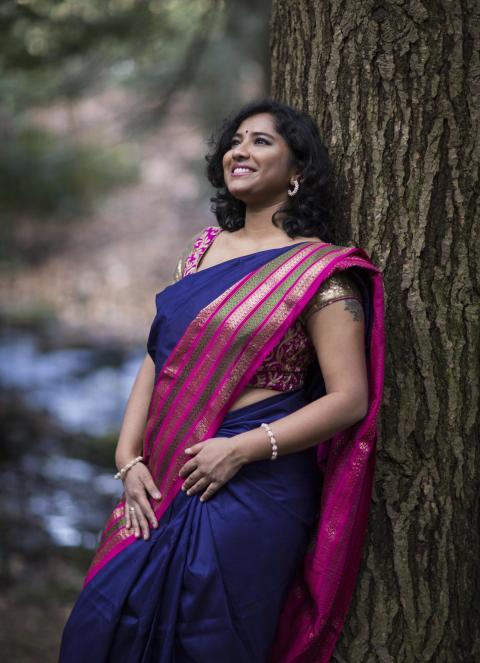
Harshitha Krishnan
Image courtesy of the artist
Harshitha Krishnan B.M. ’17 (Nigeria/India)—Voice
Could you describe your musical background?
I was accidentally discovered at the age of 4 at a school music competition that I wasn’t participating in! I didn’t realize you weren’t supposed to sing along from the audience.
I started Euro-classical voice and recorder lessons at age 6 and eventually started exploring my love for popular contemporary music around age 18, which is when I moved to India to live with my grandparents. While there, I very luckily fell into the professional music scene and began my career as a recording and touring musician. But after a couple of years of that, I realized I wanted to learn so much more about different styles of music, to push myself to be the best I could be, and to explore my own musical identity. So in 2013 I moved to Boston to go to Berklee. The rest, as they say, is history.
How did you first come to the Berklee Indian Ensemble, and what kept you involved with the group?
One of the first questions everyone asked me when I got to Berklee was, “Have you met Annette Philip?” I had not, and everyone recommended I reach out to her to connect. She must’ve missed my email, because I didn’t get a response, but we were destined to meet anyway. Later that semester, I learned through a friend that Annette was looking for volunteers to help out with the BIE recital, and I figured this would be a great way to finally meet the Annette Philip.
Once we met, we hit it off and I think we both quickly realized how well we worked together, and I realized I had much to learn from her. I volunteered as a production assistant my next semester too, until I finally decided to audition for fall 2014. I had no idea A. R. Rahman would be a visiting artist that semester and the wild ride that would follow in the years to come, but I stayed because I always feel like there is room for growth for me with this group musically and personally. The ensemble has given me a unique opportunity to understand my identity and express that through the music.
What's your favorite song on Shuruaat?
So tough! But “Pinha” is one of my favorite songs of all time. Dhruv wrote such a beautiful melody and arrangement for a poem that holds such power. It’s a match made in heaven!
What's one piece of music that has inspired your approach to playing in this ensemble?
I don’t know if there’s any one piece that influenced how I play/sing in the ensemble. The music we do is so vast and every song is so unique in how we need to approach it. But that’s exactly what I’ve learned in this ensemble. Every piece has a spirit. We’re just trying our best to release that spirit onto its listeners. We put the music above ourselves. It’s not about what I am doing on the song, but what I’m bringing to the song and whether that resonates with its spirit. But if there’s a song I’ve had near-religious experience performing with this ensemble, it’s “Tere Bina” by A. R. Rahman. It’s got such a gorgeous melody and I always feel goosebumps listening to it or performing it.
Armeen Musa
Image courtesy of the artist
Armeen Musa B.M. ’14 (Bangladesh)—Voice
Could you describe your musical background?
I grew up with a mother who is a part-time musician in traditional South Asian classical music, and a father who loved rock, pop, and blues. Their love for music always inspired me to see it as a beautiful life skill, to love and to live in sound. I wrote my own songs to find peace in my own life, to express joy and pain, and eventually realized that it was leading me to have a life of a musician.
How did you first come to the Berklee Indian Ensemble, and what kept you involved with the group?
I learned from Annette in my first semester at Berklee, and when the ensemble was formed a few months later, I knew this would be home (and it was). I was in the ensemble for the duration of my time at Berklee, because this was exactly the music I wanted to learn about and create, and as each production grew, I could see myself growing too. It is also the source of my closest friends at Berklee.
What's your favorite song on Shuruaat?
“Pinha.” It is one of the pieces that inspired me to find the courage and confidence to make “Jaago Piya,” and I cry almost every time I hear it. Lord knows how I used to rehearse and perform it back then!
What's one piece of music that has inspired your approach to playing in this ensemble?
The song “Khwaja Mere Khwaja.” I remember all of us in a group learning this piece, and though it is the song that we did the least or almost no harmonies, the collective energy of channeling this spiritual piece made me realize that it isn't always the technical beauty that matters in a song; its sometimes just its own essence.
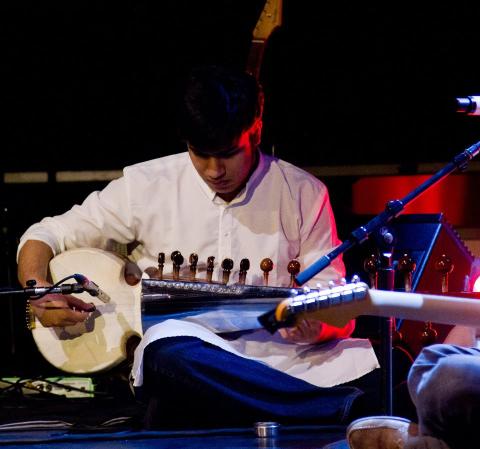
Sashank Navaladi
Image courtesy of the artist
Sashank Navaladi B.M. ’15 (India)—Sarod
Could you describe your musical background?
I come from a family of classical music lovers and started learning sarod at the age of 6 under the tutelage of Ustad Danish Aslam Khan. My sarod lessons were soon followed by more lessons in vocals and tabla, so my childhood was spent learning different forms of classical music. I discovered the art of creating music when my brother got his first laptop from his university (I was still in high school) and I downloaded Mixcraft, my first ever DAW. This was soon followed by my discovery of Logic and MIDI software, and I started creating my own songs and arrangements. I soon realized that music composition was all I ever wanted to do, which led me to applying to Berklee. Currently, I'm based in L.A. as a full-time music composer and producer.
How did you first come to the Berklee Indian Ensemble, and what kept you involved with the group?
I first saw the Berklee Indian Ensemble during the orientation ceremony for the 2012 batch of students at the Berklee Performance Center. I loved their style of playing and the arrangements, and reached out to Annette immediately after to ask if I could join. She agreed and asked me to register for the fall semester. On my first day, I was given a tihai (thrice repeating melodic or rhythmic pattern) to transcribe in the song “Rhydhun,” and that was my first assignment in the ensemble. I am grateful to Annette for fostering a collaborative environment where we could create new music, share new ideas, and for encouraging us to perform our own arrangements live.
What's your favorite song on Shuruaat?
This is a tough one because I like all the originals on the album, but one song that I’ve been hearing on repeat is “Dua” by Shadow and Light. The song is a perfect blend of Hindustani vocal lines and modern arrangement, and the lyrics have tremendous depth to them as well.
What's one piece of music that has inspired your approach to playing in this ensemble?
Anything by Shakti, really. After I joined the ensemble, I was fortunate to meet like-minded friends (Shubh, Layth, Rohith, MT) who all love Shakti, and we used to geek out on their music in our dorm rooms after class. Every song of theirs is a master class in fusion music, and I still analyze their arrangements and find something new every time. For “Arz-E-Niyaz” specifically, I drew inspiration from the compositions of Ustad Bade Ghulam Ali Khan, especially his thumri “Ab Tohe Jaane Nahi Doongi” in raag Manjh Khamaj. His style of developing verses and including improv and sargams [a system similar to solfege], while keeping the structure intact, have especially been an inspiration for the song.

Annette Philip
Image courtesy of the artist
Annette Philip B.M. ’09 (India)—Voice, Piano
Could you describe your musical background?
By age five, I knew music had to be my way of life because of the way it made me feel. More so, making music with others. I began studies in piano, trumpet, and recorder, and trained myself on vocals while living in Singapore. Returning to India as a teenager, I delved into jazz, gospel, R&B, soul, and a cappella music. I was “discovered” by a producer in New Delhi, and that led me to start recording professionally as a vocalist and voiceover artist at age 17. My love of creating community and obsession with arts productions led me to create a performing arts collective, Artistes Unlimited. That brought me massive joy but also intense burnout, which propelled me to seek inspiration. I had heard about Berklee by word of mouth. Got in, and continued to pursue my professional career even as a student (touring/creating albums/producing/directing). Just before graduating, I was offered a faculty position at Berklee and the greatest gift of all: a blank canvas. Which leads us to the next question...
How did you first come to the Berklee Indian Ensemble, and what kept you involved with the group?
I founded the Berklee Indian Ensemble in 2011. My vision was to create a safe space for musicians from any cultural or musical background to explore and express themselves within the Indian music idiom. “What if?” and “why not?” were two questions that inspired me and are now part of the culture of Berklee Indian Ensemble and Berklee India Exchange (the institute that grew from the momentum BIE created). It’s surreal to see where we are today, with a Grammy nomination for our debut album, Shuruaat. It wouldn’t be possible without the incredible family of musicians from over 52 countries that have joined us in this adventure. I owe so much to the musicians in BIE who have taught me some of the greatest life lessons. I love our team so much, and I am inspired by them on a daily basis. We’ve lived and experienced so much together. And we’re only just getting started.
What's your favorite song on Shuruaat?
“Sundari,” because of the way it evolved—it’s the most collaborative arrangement in BIE’s history, and it gives an inkling into the direction of BIE; “Pinha,” for it’s powerful lyrics and Dhruv’s unbelievable melodic lines; and “Jaago Piya,” for all the conversations it inspired in our little classroom and for the most luscious vocal harmonies we have on record to date.
What's one piece of music that has inspired your approach to playing in this ensemble?
One of our guitarists, Shubh Saran B.M. ’14, would always suggest layering (bringing instruments in one at a time when building a segment). We nicknamed it “Shubh’s Theory of Layering” and still mention it in rehearsals, although he graduated way back in 2014! I feel BIE’s sound is very layered, culturally, genre wise, and thematically. Shubh’s legacy lives on. For me as a vocal arranger, Bobby McFerrin has been a huge influence. “Baby” and his whole album, VOCAbuLaries, are constant fertile ground for inspiration, and I’m delighted Shuruaat could include dense vocal harmonies on many songs, including “Jaago Piya” and “Sati.”

Sharon S. Reynold
Image courtesy of the artist
Sharon S. Renold B.M. ’18 (Switzerland)—Electric Bass, Vocals
Could you [describe your musical background?
Growing up in a family of musicians and Berklee alumni, my road to music was already paved and ready for me to waddle over. Home was where I was introduced to old-school jazz and fusion jazz, which laid out the perfect foundation for the music I find myself doing today. Just like most nerdy music teens, I went through various genre phases, from punk through to musical theater and eventually leaning into various styles from all over the world.
How did you first come to the Berklee Indian Ensemble, and what kept you involved with the group?
I first met Annette in Switzerland in 2009 at my parents’ jazz festival, Jazzaar, where she was invited to come and sing for a Louis Armstrong tribute show. Fast forward a few years later, I found myself at Berklee, reconnecting with her and eventually joining the ensemble as an electric bassist and choir vocalist. This group is really more than an ensemble; it’s a family. The music and the projects we do are definitely some reasons to stick with the group, but quite frankly, it’s all about the people I get to play and spend endless hours with.
What's your favorite song on Shuruaat?
Tough one! It’s gotta be a tie between “Sundari Pennae” and “Dua.” To me, both songs combine skill and beauty in the best possible ways and perhaps are an introduction to the newer and future sound of this group going forward.
What's one piece of music that has inspired your approach to playing in this ensemble?
That's an interesting question. More than a single tune, I actually think it is the individuals who I get to play with, the composers, the arrangers of songs we've covered, and maybe most importantly, the people who played in this ensemble before me, that inspired my approach the most. In regard to writing "Akash," I wanted the song to sound earthy and raw, as it represents cycles and rebirth. So, for the chorus of “Aakash” I took inspiration from the song “Through Heaven’s Eyes” from the Prince of Egypt soundtrack, mimicking the energy and tribal vocal sound.
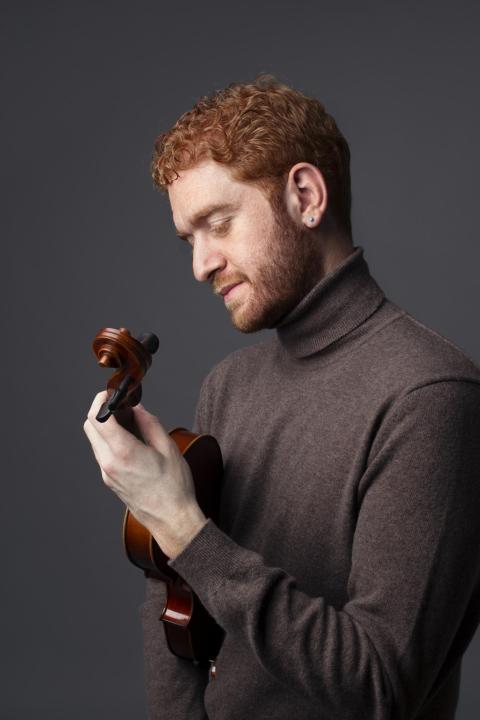
Layth Sidiq
Image courtesy of the artist
Layth Sidiq B.M. ’14, M.M. ’16 (Iraq/Jordan)—Violin
Could you describe your musical background?
I was born in Baghdad into a musical family, but then moved to Jordan at the age of one. I started playing the violin at the age of 4 and I was constantly touring and performing, representing Jordan at international festivals and events. At the age of 16 I was accepted into the prestigious Chetham’s School of Music in Manchester, England, a private music boarding school where I finished my high school diploma and studied under some of the greatest violin teachers in Europe. I then applied to Berklee, where I was accepted with a full scholarship, and since then I have acquired my bachelor’s and master’s degrees from Berklee and have had the chance to tour and perform with some of the world’s most celebrated artists. I’m also an award winner, having won second place at the Seifert International Jazz Violin Competition, as well as Best International Artist at the Boston Music Awards. I now spend most of my time touring the world to present my music, as well as recording on high-level projects, such as the new Assassin’s Creed game, Mirage, where I’m the lead vocalist and violinist.
How did you first come to the Berklee Indian Ensemble, and what kept you involved with the group?
I joined the Berklee Indian Ensemble during my second semester at Berklee, which was also the second semester this ensemble was being offered as a class. So you could say I’m one of the first members who are still actively participating in the ensemble. I stayed involved with the ensemble mostly because of the great friendships I’ve developed with the countless musicians who have been part of it, as well as the passion it’s helped me develop towards Indian music in all its forms. There are always new opportunities and challenges, and they really helped me grow both during my time as a student, and then after as a professional musician.
What's your favorite song on Shuruaat?
All the songs are wonderful and have different backstories, but my favorite one is “Jaago Piya” by Armeen Musa. A hauntingly beautiful melody and a special arrangement. I could also be biased because I had a long featured solo in the middle of the song, but more than that, I remember—with great fondness—the time when we recorded this piece and how there was an overwhelming sense of community, friendship, and love. As someone who was living and making a living far away from home, those were moments I cherished and will never take for granted.
What's one piece of music that has inspired your approach to playing in this ensemble?
Anything by Shakti has definitely been a real inspiration, but the one song that initiated the first spark for me with this group is “Ishwar Allah” by A. R. Rahman. We used to play this song almost every semester when the group was formed and it was such a grounding piece that will forever tie me with this group.
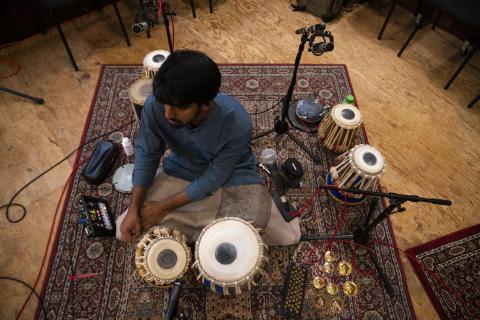
Giri Subramaniam
Image courtesy of the artist
Giri Subramaniam (India)—Tabla, Percussion
Could you describe your musical background?
I started learning Carnatic vocal music from my mother when I was 5. My mother and grandmother used to take music classes at home and perform regularly at concerts. My father learned mridangam briefly from Vidwan T. H. Vikku Vinayakram, and wanted me to pick up a percussion instrument. I learned tabla from Muthu Kumar, student of Ustad Alla Rakha and Ustad Zakir Hussain, and I continued learning from various maestros by attending workshops and master classes. Ever since I met Muthu I have always wanted to be a tabla player, so I took my tablas with me wherever I went for higher education. When I reached Boston to do my Ph.D. in economics, I met the Berklee Indian Ensemble.
How did you first come to the Berklee Indian Ensemble, and what kept you involved with the group?
I have a vivid memory of watching the Berklee Indian Ensemble’s “Jiya Jale” music video on YouTube, and I thought that I should meet members of the band when I’m in Boston but never got to for the first two years after I arrived. In 2016, I got to attend one of their concerts and was absolutely blown away. Later that year, the ensemble was planning a show with the legendary singer and composer Shankar Mahadevan, and they were looking for a tabla player. I auditioned, got in, and have been playing with the band ever since.
What's your favorite song on Shuruaat?
It would have to be “Lady L.” I was not a part of the performance but I got to assist with the soundcheck and with setting up Ustad Zakir Hussain’s tablas for the recording, and I watched the magic unfold from the best seat in the house! That will always be a special memory for me.
What's one piece of music that has inspired your approach to playing in this ensemble?
As a tabla player, Shakti has been a huge influence on my style of playing as well as in serving as a guide to playing crossover music. The entire Natural Elements album by Shakti inspired me to rethink the role of tabla as an accompaniment instrument. If I have to pick, “The Daffodill and the Eagle” is one song where complex rhythms and patterns are presented in an accessible and enjoyable manner, and that’s something we try to do with this band as well.
Listen to the full playlist on on Spotify:
